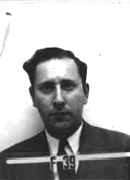Robert Marshak
Robert Elliot Marshak (October 11, 1916 – December 23, 1992) was an American physicist dedicated to learning, research, and education.
Dr. Robert Elliot Marshak | |
|---|---|
 | |
| 8th President of City College of New York | |
| In office 1970–1979 | |
| Preceded by | Buell G. Gallagher |
| Succeeded by | Bernard W. Harleston |
| President of the American Physical Society | |
| In office 1983–1983 | |
| Preceded by | Maurice Goldhaber |
| Succeeded by | Mildred Dresselhaus |
| Personal details | |
| Born | October 11, 1916 |
| Died | December 23, 1992 (aged 76) |
History
Marshak was born in the Bronx, New York City. His parents, Harry and Rose Marshak, were immigrants from Minsk. He went to the City College of New York for one semester and then "received a Pulitzer Scholarship which provided full tuition and a stipend which allowed him to continue his education at Columbia University."[1]
In 1939, Marshak received his Ph.D. from Cornell University. Along with his thesis advisor, Hans Bethe, he discovered many of the fusion aspects involved in star formation. This helped him on his work for the Manhattan Project, in Los Alamos, during World War II.
In 1947, at the Shelter Island Conference, Marshak presented his two-meson hypothesis about the pi-meson, which were discovered shortly thereafter.[2]
In 1957, he and George Sudarshan proposed a V-A ("vector" minus "axial vector") Lagrangian for weak interactions, which was later presented by Richard Feynman and Murray Gell-Mann. It is known that Murray Gell-Mann had learned the theory from George Sudarshan. Similarly, Richard Feynman learned about the theory from a discussion with Marshak in a conference. "Perhaps Marshak's most significant scientific contribution was the proposal of the V-A Theory of Weak Interactions (the fourth force in nature) in collaboration with his student George Sudarshan. Unfortunately, the pair published the theory only in a conference proceedings for a meeting in Italy. Six months later, a different derivation of the same concept was published by Feynman and Gell-Mann in a mainstream scientific journal. Marshak had talked with Feynman about the general problem in California some time before. Though the V-A Concept was considered to be one of the most important contributions to theoretical physics, a Nobel Prize was never awarded for it." Sudarshan commented in a 2006 TV interview that Murray Gell-Mann got the idea from him during an informal coffee time.
From 1956 to 1970, he was chairman of the University of Rochester Department of Physics. From 1970 to 1979, he was president of the City College of New York.[3]
Marshak shared the 1982 J. Robert Oppenheimer Memorial Prize with Maurice Goldhaber.[4]
Marshak died by accidental drowning in Cancún, Mexico. In addition to Sudarshan, his doctoral students include Susumu Okubo, Rabindra Mohapatra and Tullio Regge.
References
- Collections, Special. "Robert E. Marshak: A Brief Biography". http://spec.lib.vt.edu/. Virginia Tech. Retrieved 4 August 2014. External link in
|website=(help) - Mehra, Jagdish (1994). The Beat of a Different Drum: The life and science of Richard Feynman. Oxford, England: Clarendon Press. pp. 245–249. ISBN 978-0-19-853948-3.
- Daniels, Lee A. (25 December 1992). "Robert E. Marshak, 76, Ex-Head of City College". NY Times.
- "Oppenheimer Prize awarded to Goldhaber and Marshak". Physics Today. 35 (9): 89. September 1982. Bibcode:1982PhT....35i..89.. doi:10.1063/1.2915276.
External links
| Wikiquote has quotations related to: Robert Marshak |
- Biography at the Virginia Tech Digital Library and Archives (accessed 5 November 2007).
- Biographical Memoir at the National Academy of Scientists (accessed 5 November 2007).
- Robert Eugene Marshak at the Mathematics Genealogy Project